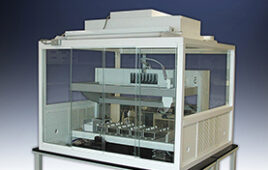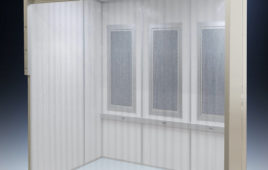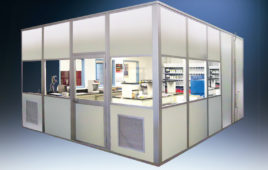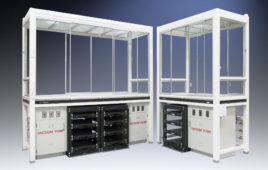In our October column1 we discussed newer microscopic techniques that have the potential to enhance our view of surface contamination in situ and provide more comprehensive information about contaminants and surface quality. However, direct observation of the surface may not answer all questions, and it is not always feasible.
Indirect analysis—analysis after extraction of analytes from the surface—is often necessary. It may be desirable to know the level of residue per unit surface area whether or not the harmful contamination is evenly distributed. This average level can provide an important quality control vector not only for product but also for fixturing (tooling) and for disposables that come into contact with the product such as wipes, swabs, and gloves. In addition, for complex, ornate components—especially those containing blind holes—contaminants may be impossible to visualize by direct surface analysis. The key to successful extractive analysis is to understand the details. This involves understanding the technique and frequently interacting with the analyst.
The solvent
An indirect analysis frequently utilizes extraction of the contaminants from the surface. Head-space analysis, where contaminants are coaxed off of the surface in the vapor phase, may be a valid approach, but it is not applicable or appropriate for all situations. Extraction is usually thought of as a washing or dissolving process employing a liquid.
Typical extraction techniques involve exposing the product, component, or witness sample to an appropriate solvent, concentrating the solvent appropriately, and then analyzing a concentrate of the bath water. Because the extract is typically concentrated, the quality and purity of the “bath water” is critical.2 This is true whether the bath water is water or methylene chloride. The American Chemical Society (ACS) sets requirements and develops validated methods to determine the purity of analytical reagents.3 In addition, the grade or type of solvent used depends on specifics of the analysis to be performed. Some of these types or grades, such as spectrophotometric HPLC grade, and those for pesticide residue analysis, are more generic. Other grades may be specific to a particular solvent supplier, and certifications of analysis that provide details of residue can sometimes be obtained. If the analysis is especially critical, ask the analyst what solvent they select, and why.
What solvent should you use? The solvent may be called out by customer requirement or industry specification. However, it is easy to make assumptions, to select a solvent because it has always been used. Question those assumptions. The extraction solvent may be of very high, well-characterized purity; if it is the wrong solvent, we may be led to a false sense of security. For example, say that a new product is being produced and we want to determine if residue is contaminating process equipment. If most contaminants are water-soluble, water may be the right extraction solvent. However, if the contaminant in the new process has only limited solubility in water and is relatively lipophilic, we may also need to consider extraction in an organic solvent as well. Let us suppose that the final product will be assembled from components supplied through a global supply chain. This raises the specter of mixed soils and of soils of unknown composition. Here, an analogy might be made with a patient showing up with an infection that is not readily identified. The best “cure” might be a broad-spectrum antibiotic rather than a drug that attacks a specific disease organism. In the world of extraction, one analogy, albeit an inexact one, might be to select two or even three extraction solvents with different solubility parameters.
Cleaning versus extraction
Cleaning and extraction have many similarities4; however, the goals and potential “tripping points” are different. For cleaning, we are not necessarily concerned about reactivity with the cleaning agent, as long as the soil is effectively removed from the surface and kept from the surface. Analysis of the extract may involve determining levels of particulates, or of non-volatile residue. Also after extraction, we may want to do speciation, to identify or at least categorize the soil. This means that the extraction chemical should not react or change the chemical nature of the soil.
Extraction is a process
Because the temperature and forces involved in an extraction can impact the results, it is important to understand details and terminology of the extraction process.
“Static extraction” is sometimes used to describe a more passive extraction process, in contrast with a dynamic extraction where agitation or ultrasonics are used. Depending on the lab, digestion can be used to mean a dynamic solvent extraction. In other instances, digestion may mean reaction with an acid to free the acid from a complex matrix that may involve organics and inorganics.
Soxhlet extraction is a process analogous to vapor degreasing. The sample to be extracted is held in the vapor zone of a chamber containing solvent at the boiling point. Freshly-distilled solvent condenses on the part; the contaminant is carried back into the boiling chamber. Using freshly-distilled solvent maximizes the potential solubility of the contaminant(s) to be removed.
Extraction processes have the potential to react with the contaminants or to cause contaminants to react with each other in such a manner that misleading results are obtained. They may also extract constituents of the surface, which can be mistaken for contaminants, or react with contaminants, or mask contaminants, further muddying the waters.
Testing is a process, too
Getting the most from testing requires careful planning and understanding of both the benefits and limitations of the analytical technique. This understanding goes beyond extraction. The bottom line is that next time you plan to spend money on a test, take the time to learn about it; and get to know your laboratory analyst.
Acknowledgement: The authors wish to thank Mark Camenzind, Sr. Technical Advisor, Air Liquide Electronics US LP – Balazs NanoAnalysis, for his insightful comments and support materials.
References
1. B. Kanegsberg and E. Kanegsberg, “20/20 Acuity: New CAR in the Future?” Controlled Environments Magazine, Oct. 2013.
2. B. Kanegsberg and E. Kanegsberg, “Are the Cleaning Agents Clean Enough? Parts I-III,” Controlled Environments Magazine, 2008.
3. Reagent Chemicals, Specifications and Procedures. 10th Edition, American Chemical Society Specifications, 2005.
4. B. Kanegsberg and E. Kanegsberg, “The Right Extraction,” Controlled Environments Magazine, April 2009.
Barbara Kanegsberg and Ed Kanegsberg (the Cleaning Lady and the Rocket Scientist) are experienced consultants and educators in critical and precision cleaning, surface preparation, and contamination control. Their diverse projects include medical device manufacturing, microelectronics, optics, and aerospace. Contact: [email protected]
This article appeared in the November/December 2013 issue of Controlled Environments.




